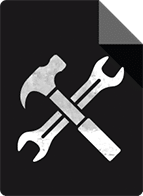Lots of website traffic is a great thing. Lots of targeted, qualified website traffic is even better. But what good does that traffic do for you if you don’t know who these visitors are and therefore can’t contact them? Below I’ll show you how to turn your website traffic into real contacts and leads using the inbound methodology for your industrial marketing.
Four key components define a website’s lead conversion path:
1. Premium content offer
I use the following stat and the accompanying quote all the time, but for good reason.
According to a study by KISS metrics, 96 percent of website visitors are not ready to buy. So what are they doing? To quote Google,
“Our research has shown that, on average, business buyers do not contact suppliers directly until 57 percent of the purchase process is complete. That means for nearly two thirds of the buying process, your customers are out in the ether: Forming opinions, learning technical specifications, building requirements lists, and narrowing down their options, all on their own, with minimal influence from you.”
Website visitors come to learn, not to be “salesmanned.” They seek value, not an advertising message screaming:
“BUY FROM ME NOW!”
As a result, B2B companies become teachers that must educate their audience and earn their trust. Premium content offers exist for that exact purpose – to “sell” your audience value in exchange for the right to contact them. And just like a product or service, if the content is garbage, no one will pay for it.
Premium content offers come in many forms:
- White papers
- ebooks
- Case studies
- Buyer’s guides
- Webinars
- Recorded videos
- Product demos
- Manuals or handbooks
Publish premium content that makes the most sense for your particular audience. Write white papers and informational guides (like this B2B Website Planning Handbook) that appeal to those in the exploratory stages of their buying process. Write others that appeal to those closer to a buying decision. Develop a buyer’s guide for CEOs and a separate buyer’s guide for project managers. Host a live webinar targeting one key vertical and another webinar targeting a different vertical. Cover all key audiences by creating valuable resources just for them and your lead-capture ability will skyrocket. Remember that every buyer is different. Not all of these tactics make sense for everyone, so pick and choose those you feel add the most value for your audience segments.

Learn how to grow your business online.
Our free Industrial Marketing Guide will show you how to attract qualified website visitors, convert them into real leads and nurture them through the buying process.
2. Call-to-action
Ask and you shall receive. But as we just explored, don’t only ask for the big sale. With content offers now established for your audience, exposure to those offers takes priority. Calls-to-action define the success of every individual page of your website. Think strategically and put yourself in the shoes of your audience. Consider the make-up and needs of visitors for every page, and think about their likely place in the buying process when they visit any given page. Include at least one call-to-action on each page for those in their research phase (“download our white paper to learn more about our philosophy on this topic”) and one call-to-action for those closer to buying (“download our case study to see how we helped another customer succeed”). This approach targets different individuals and their different needs rather than shouting at them to buy now.
3. Landing page
“Landing page” in marketer speak means “lead-capture page.” Any given call-to-action on your website should drive a visitor to a landing page that serves one purpose alone: capturing that visitor’s information. Think of landing pages as the checkout aisles of your website. The transaction happens here — your premium content is exchanged for your prospect’s contact info. Landing pages require a unique design compared to other pages on a website. Plan to strip away exit points from that page so your visitors focus only on completing the page’s information-collection form in exchange for your offer. Remove the top navigation and other prompts that might drive them away from the page. In terms of page content, focus on briefly summarizing the offer at hand. If you offer a case study download, include a one-paragraph summary of the case study and a few bullet points about results. Next to the summary, include your info-collection form with a clear reinforcement: “Download now.” The following links take you to a few sample landing pages we’ve created on our own website:
- White paper landing page example: The B2B Website Planning Handbook
- Case study landing page example: Traffic Generation and Lead Generation Case Study for Industrial Painting Company
- Free consultation landing page example: Free Marketing Assessment
4. Form
Don’t under-think the forms that live on your landing pages. Collect the basics of course: name, company, phone number, email address. But then get creative. Ask questions that will prepare you or your team for a sales call — information that will help qualify your prospect as a good or bad lead. Ask visitors about their biggest challenges and what services they would find helpful. Ask about their industry and the size of their company. Ask if they’d be interested in talking to a sales rep or if they’re just researching. And ask what type of content they’d find valuable from a list of four or five topics so you can cater your email marketing approach toward each prospect accordingly.
Today, marketing automation software such as Hubspot elevates the collection of lead intelligence to another level. The term “progressive profiling” refers to a marketing automation system’s ability to gather different information from any given visitor every time he or she fills out a new form on your site. So while you might only ask for name, company, phone number and email address upon the first white paper or case study download, your website will recognize return visits and skip those questions in lieu of more insightful ones the second time around. Over time, the marketing profiles of individuals in your database become more robust. New information helps you score and segment leads and allows you to market accordingly to them moving forward. As a bonus, your sales team will love you for the lead intelligence you’ve provided before they ever make their first calls to prospects. Learn more about marketing automation here.
In conclusion…
Don’t let your website visitors get away! Because there’s no guarantee a visitor will return, visits become meaningless unless you create opportunity for dialogue.
This article is just a short chapter in our B2B Website Planning Handbook. If you found it helpful, download the full guide.
